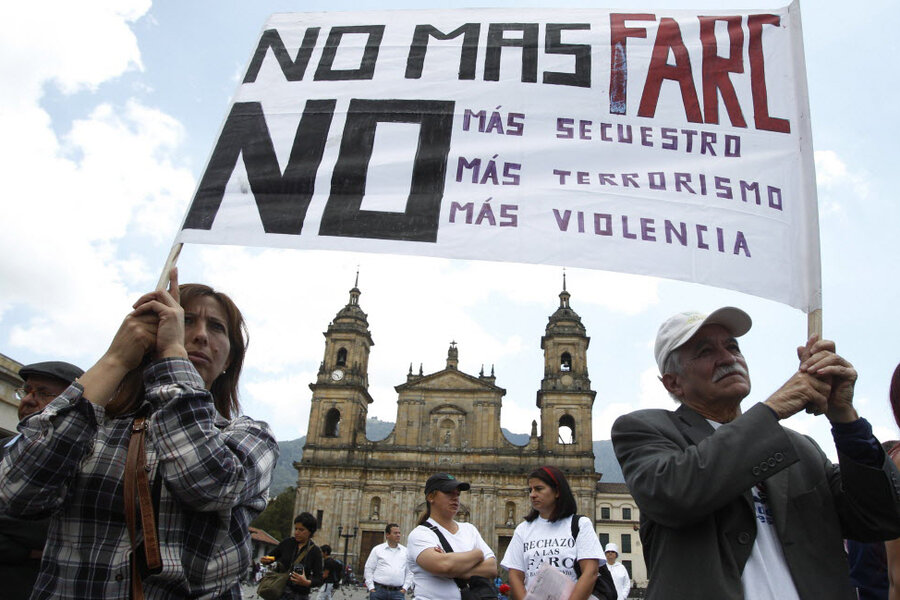Colombia: Violence flares in lead-up to new round of FARC peace talks
Loading...
| Bogotá
Colombian government and rebel negotiators begin a new round of peace talks today, even as hostilities between the two sides intensify and test the patience of war-weary Colombians. But the fact that negotiations have withstood the strain is a promising sign of the strength of the process, analysts say.
Tensions rose at the peace talks last month – which are being held in Havana between the Colombian government and rebels of the Revolutionary Armed Forces of Colombia (FARC) – when the guerrillas seized two policemen and a soldier following the lifting of a unilateral cease-fire Jan. 20. The policemen were released on Friday and the soldier on Saturday, after being held for several weeks.
When leaving Bogotá for Havana yesterday, the government’s top negotiator, Humberto de la Calle, said he recognized “the release of the policemen and the soldier by the FARC,” but repeated that “kidnapping is an unacceptable crime.”
However, the release did not signify a new wave of calm in Colombia. While the policemen were being released from captivity in southwestern Colombia, the FARC ambushed an army unit just 20 miles from the capital, Bogotá, killing three soldiers and wounding another three. That was followed Saturday by a predawn attack on a police station in the town of Puerto Asis, Putumayo, near the border with Ecuador, which left the police station in ruins and damaged more than two dozen homes. Government troops have also struck out against the rebels, killing the leader of the FARC’s Fifth Front and five others when they stormed a guerrilla camp Jan. 31.
Public opinion
The kidnappings and the intensified fighting have increased public skepticism about the peace talks. A Datexco survey published Monday showed that just 32 percent of Colombians polled approve of the way President Juan Manuel Santos is handling the peace process, and only 20 percent believe the talks will lead to a peace deal.
Oscar Quintero, mayor of the town of Caloto, Cauca, said at a meeting with peace commissioner Sergio Jaramillo that the violence in his municipality “is just as bad as it was before the peace process started.” Cauca, located in southwest Colombia, is one of the provinces hit hardest by the conflict.
“Public opinion needs to see fighting diminishing” in order for citizens to buy into the peace process, says Kristian Herbolzheimer, director of the Colombia program at Conciliation Resources, a nongovernmental organization dedicated to peace building.
But the fact that recent events and tensions did not upset the agenda in Havana shows a commitment by both sides to see the process through to a peace deal, says Mr. Herbolzheimer. “If this is the biggest crisis the talks have faced until now, it is a good sign, because it wasn’t really a crisis,” he says.
However it has given fodder to critics of the peace process, such as former President Álvaro Uribe. Mr. Uribe, whose two terms in government (2002-10) were characterized by an all-out offensive against the FARC, claims that his successor and former defense minister has gone soft against “terrorists.” After the FARC attack on the police station Saturday, Uribe posted a photo of the debris on Twitter with the message: “Another attack by terrorists and the government in impunity talks with the leaders.”
'Kicking each other under the table'
The FARC have proposed a renewed bilateral cease-fire while the peace talks proceed, but the government has rejected the idea.
“While from a humanitarian perspective [a cease-fire] makes sense, militarily it could give the FARC some breathing space,” says Herbolzheimer, a risk the government cannot afford to take either politically or militarily. Such a truce would also be complicated to enforce and could be very easy to sabotage by critics of the process who could commit violent acts to make it look as if one side or the other violated the truce, he added.
Eventually, however, both sides will have to find ways to de-escalate the fighting even without a full cease-fire, says Carlos Alfonso Velásquez, a retired Army colonel. “They can’t keep kicking each other under the table and keep smiling above it,” Mr. Velásquez says.
Herbolzheimer agrees, suggesting that the two sides could take unilateral measures to show Colombians the benefits of the process while building confidence between the two negotiating teams. For example, the FARC could commit to limiting actions to nonurban areas and the government could pledge not to go after top leaders, although such decisions would probably not be made public. “In the medium term, fighting and talking will become incompatible,” he says.
Editor's note: The story previously misstated Mr. Velásquez's Army ranking.







